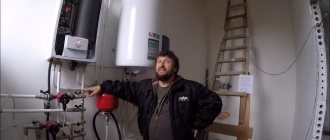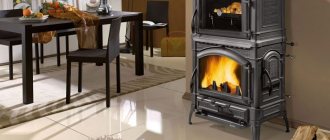Natural gas continues to be the most profitable coolant, and a gas boiler is the most convenient equipment for heating a private home. Owners of gas boilers have at least once encountered or heard about such an unpleasant phenomenon as spontaneous extinguishing of a gas boiler.
And although the automation of modern devices excludes the supply of gas when the burner flame disappears, the house cools down quite quickly in winter. In the absence of owners, the water in the pipes of the heating system may freeze, which will lead to catastrophic consequences. Therefore, if you observe episodic or regular extinguishing of the boiler, you need to find out the reason and find a way out.
Why does a gas boiler go out?
Unfortunately, calling a gas service technician is not always convenient, and sometimes you have to wait a long time for his visit. However, there are a number of cases when you can fix the problem yourself. In other situations, on the contrary, even a visit from a professional will not save you - if the culprit is the weather with strong squally winds or improper design and placement of the gas outlet pipe.
Typical problems of double-circuit boilers
Double-circuit modifications of gas boilers, intended for the preparation of coolant and hot water, can also fade for all the reasons described above. But if there are no signs of the above breakdowns, perhaps the problem is caused by the specific features of the unit.
These include those that arise due to the operation of the water overheating protection system, namely:
- mixing hot and cold running water;
- thinning of the walls of the gearbox membrane.
The instructions for boilers with an additional heat exchanger for domestic hot water usually warn that two taps cannot be opened at the same time. It is better to initially select the most suitable temperature for heating hot sanitary water in the settings.
The fact is that when cold water is turned on, the consumption of hot water decreases, and heat is generated in the same mode, overheating the heat exchanger. Due to overheating, the automatic system is activated, which shuts off the gas supply and blocks the operation of the boiler.
There are many more reasons why a DHW boiler goes out due to the peculiarities of its design. The problem can be solved quite simply: to avoid overheating, choose a comfortable water temperature by changing the regulator on the control panel
If operation is carried out according to the instructions, but the dual-circuit unit still turns off, you need to change the gasket of the water unit. Most likely it is worn out.
Clogged igniter and burner nozzles
Natural gas, which runs in household pipelines, is not a 100% pure substance - it contains additives and impurities. Some of them are added intentionally (for example, to create a specific “gas smell”), others are formed as a result of careless cleaning.
And the gas itself (a mixture of methane and in small quantities - propane, butane and ethane) does not burn without a residue - hours of operation of the burner generate soot and soot, which gradually settles on the boiler parts and can lead to clogging and clogging of thin channels and holes - jets , through which gas is supplied to the igniter and the burner itself.
An atmospheric boiler igniter is a special device that allows a small flame to burn. When the gas supply is turned on cyclically, it is the gas that ignites the mixture supplied from the burner. A constantly burning “wick” smokes even more than a burner, since the pressure in the igniter is low. If soot clogs the pilot nozzle, the boiler will not be able to turn on the next time.
A sure sign of clogging and sootiness of the igniter is the yellow color of the flame. Therefore, the igniter must be cleaned in a timely manner to prevent the channel from blocking.
Burner nozzles become clogged much less frequently, since gas is supplied there under pressure in large portions, but this situation cannot be completely excluded.
Expert opinion
Filimonov Sergey Vinokurovich
Heating equipment repairman
If you decide to clean the jets yourself, be careful. The fact is that the nozzle channels are made of relatively soft metals - copper or brass. Using steel wire or a brush can damage the equipment. Use copper wire or a brass brush.
How to deal with clocking?
Timing is a very specific term used by heating equipment installers.
It means that the gas valve is opening and closing too often. It is believed that clocking leads to premature mechanical wear of burner parts, but neither manufacturers nor those involved in servicing heating systems have accurate statistics.
For most valves of household gas burners there are no standards for the number of operations per unit of time. Therefore, clocking does not always mean that there is a serious malfunction or defect, but, nevertheless, it signals that certain problems still exist, and they need to be looked for in the heating system. The most common reasons for this valve behavior are:
- Excessive boiler power.
The heating system (radiators, registers) does not have time to dissipate the amount of heat generated by the burner. If you do not plan to expand the heated area, then the only way out is to replace the burner with a less powerful one. - There is not enough performance or pressure of the circulation pump.
All central heating units for domestic heating systems have 3 operating modes. If switching to the highest capacity does not help, you need to replace the pump. - Poor hydraulic balancing of the heating system.
The solution is obvious: perform balancing.
It is also necessary to remember that in spring and autumn, when the heat loss of the building is low, almost all boilers controlled by a built-in thermostat operate. Installing a room thermostat and/or weather-dependent automation solves the clocking problem and helps reduce gas consumption in the off-season.
Solenoid valve or thermocouple malfunction
Automatic gas supply, even in the simplest floor-standing atmospheric boilers, includes an electromagnetic valve that opens the gas supply and a thermocouple.
A thermocouple is essentially a metal sensor that monitors the presence of temperature, sends a signal about it to the solenoid valve, which, in turn, opens the gas supply to the burner. The thermocouple registers the operation of the igniter.
If the igniter works, but it is faulty, then the boiler will go out and will not turn on again without a restart or never at all (depending on the degree of failure). The same thing will happen if the reason is in the solenoid valve - even if there is a signal from the thermocouple, the gas supply may be stopped.
Both the thermocouple and the solenoid valve can be changed independently if you have the appropriate tools and skill. However, in the absence of experience, it is still recommended to resort to the services of a specialist, since the boiler is operating normally.
What to do to solve the problem
If you have a heating system equipped with a complex electrical control panel, then there is no need to try to fix the problems yourself. Here it is better to entrust the work to specialists who have the necessary tools and professional equipment. Another thing is when the problem is not related to electronics, here you can fix everything on your own.
- If the gas pressure on the burners is low, and everything is fine with the line itself, you need to look for the reason in the fittings and the meter. Check to see if there are any blockages. When the fault is on the side of the gas service, contact them and demand that the pressure be restored to normal. You can increase the boiler power so that the temperature of the exhaust gases rises accordingly, the pipe warms up more and the problem simply disappears.
- Boiler malfunctions may be associated with a breakdown of the ignition device. Sometimes it’s enough to just take it out, remove all the carbon and debris, thoroughly clean the pilot hole and that’s it. But there are times when all the settings for this element are lost. You will have to adjust the level of gas pressure and draft so that the flame behaves stably.
- Pay attention to the error codes that appear on the electronic display. This makes it easier to determine the cause of the malfunction and eliminate it.
Lack of air draft in the system
An atmospheric gas boiler operates on the same principle as its ancestors - coal and wood stoves. Natural gas burns when air enters, and combustion products are carried out through the chimney outside the house.
Lack of traction in the system
In order for the entire system to work successfully, draft is necessary - a constant flow of air from the boiler burner to the head of the chimney. If there is no draft, the combustion products will not leave the combustion chamber at the required speed, and the boiler will go out.
Expert opinion
Filimonov Sergey Vinokurovich
Heating equipment repairman
Traction can be checked with a match or lighter. If you bring their light to the burner window (while turning off the gas supply), you can see the deflection of the flame. Inward means there is a thrust, the flame does not move - there is no thrust. Sometimes the light deviates towards the room - this means reverse thrust.
Next, remove or disassemble the outlet pipe to the chimney. In modern boilers, this is simply done by loosening a couple of screws or loosening special quick-assembly clamps. After checking the draft, it becomes clear where the reason for its absence is - in the boiler itself or in the chimney.
During operation, the chimney not only becomes clogged with soot and other combustion products. Birds or collective insects (for example, wasps) can accidentally or intentionally get into it by making a nest. This happens in the summer when the chimney is idle.
How to fix a boiler that is running in short cycle mode
We strongly advise against repairing the boiler yourself. Repairs and replacements of gas equipment must be carried out by an engineer.
Sometimes boiler repairs don't make financial sense. Instead, replacing the unit can be a much more cost-effective solution.
As boilers age, they become less reliable and require repairs more often. Those boiler repair bills will start to add up, and there will come a point where boiler replacement becomes your best option.
Depending on the type of boiler being installed, the cost of repairs can vary from thirty to sixty thousand rubles, including installation. Considering that some spare parts can cost between RUB 5,000 and RUB 10,000, this long-term investment in a boiler replacement may be the smartest move.
Expert opinion
Torsunov Pavel Maksimovich
You should consider replacing your boiler if your boiler is over 8 years old, breaks down regularly, engineers are having trouble finding replacement parts, or your gas consumption figures are rising.
Modern boilers are much more reliable than old units and come with a warranty period. The warranty will eliminate additional costs if the unit unexpectedly breaks down, and the new boiler will improve the efficiency of your heating system, which will help reduce your heating bills.
Outlet pipe, reverse draft and wind
A case that deserves special attention is the incorrect design of the chimney outlet pipe, which creates reverse draft. The fact is that air flows can, reflected from obstacles located near the head of the pipe, blow combustion products back into the pipe and extinguish the burner flame.
Such obstacles can be densely growing tall trees, the wall of a house or the ridge of a roof. In the second and third cases, the cause is incorrect placement of the end section of the chimney. The correct location is above the highest point of the house.
Sometimes in nature there is such a phenomenon as a downward wind. Its flows are not directed horizontally, but at an angle to the surface of the earth, sometimes almost at a straight line. This means that a strong gust will blow from top to bottom directly into the pipe and, regardless of the location of the tip, return gases to the chimney channel.
In order to compensate for the phenomenon of downward wind, there is only one way - to cover the tip with a fungus, leaving sufficient distance for the burnt gases to escape.
Excessive and insufficient air supply
Each of the presented phenomena can cause attenuation. In order for the boiler to function normally, there must always be an air flow into the firebox through the ventilation system. At the same time, drafts should not be allowed to occur in the room, otherwise this will lead to the burner blowing out.
To understand whether there is enough oxygen in the room, you need to open the window and watch how the flame behaves. Here's why this happens:
- When installing modern sealed windows, the flow of fresh air may be cut off.
- If the kitchen hood is too powerful, it may happen that most of the air flow is drawn due to it.
- The interior doors in the house have been updated. The gaps between the floor and the doors have decreased, hence the problems with the supply of oxygen.
- A similar effect is observed in a situation where a hood is installed in a bathroom or toilet.
Lack of air for gas combustion
Problem related to lack of traction. Even if the boiler and chimney are in order, the lack of fresh air entering the combustion chamber of the burner can lead to the flame extinguishing.
From our school physics course we know that combustion requires oxygen. The powerful flame of the burner quickly burns it out of the air, turning it into carbon dioxide. If very little new air enters, the combustion stops, the flame subsides, and the automation turns off the gas supply.
The cause of air deficiency in the room where the boiler is located may be:
- tightly closed windows with seals;
- closed solid doors with a high threshold;
- improperly organized ventilation (air is taken in by a hood, exhaust fan or other active devices).
Expert opinion
Filimonov Sergey Vinokurovich
Heating equipment repairman
For the operation of atmospheric boilers, good supply ventilation in the boiler room or other room where the gas unit is located is mandatory!
Gas burner goes out
It is also possible that gas and electricity in the AOGV (Gas Water Heating Unit) are available in the required volume, but the burner constantly goes out. The equipment turns on, works, and then the flame in the firebox goes out. Here the problem may lie in the draft or the thermocouple that controls the presence of fire. It is possible that there is either a lack of air for combustion or a breakdown of the internal elements of the boiler.
The first option is a malfunction of the traction sensor or its absence in principle. To check whether there is an air flow into the firebox, just hold a burning match to the inspection window of the gas boiler. The flame should deviate towards the firebox. If it is motionless, then there is no traction.
In this case, first you need to open the windows and door slightly so that the air enters the furnace room. If this does not help, then you will have to clean the boiler and chimney. The cause of the problems lies in them, or more precisely in the accumulations of soot on the walls of the pipe and firebox.
The second option is a thermocouple. The contacts of this sensor may simply come off. As a result, the relay that shuts off the nozzles constantly receives signals that the fire has been extinguished. Fuel should not flow into the combustion chamber; the solenoid valve shuts off its supply. It is necessary to check the connection of this device to the damper. The connector should be free of oxides and dirt. If there are any, you will have to clean them with fine sandpaper.
Checking the thermocouple
Pressure drop in the gas line
If the gas does not supply at the required pressure, the burner goes out and does not turn on. The reason for the drop in pressure may be routine work on the gas pipeline or a leak. The latter can occur outside the site or on its territory.
Carefully check the gas inlet along the entire length of the pipe. If there is a leak somewhere, the smell of gas and hissing will tell you everything. If you find a leak, do not try to fix it yourself! Call the gas service.
Sometimes the cause of insufficient pressure at the boiler inlet can be a clogged or faulty meter. Since it is sealed and it will not be possible to disconnect the pipe, you will also have to call specialists to check it.
The boiler does not turn on
If the boiler does not turn on at all, then among the reasons for this may be:
- Problems with the burner;
- Insufficient gas pressure in the line;
- Valve closed by mistake;
- No voltage in the electrical network.
What to do in such a situation? First you need to check the availability of electricity and the supply of gas fuel. If all the power is available, then you need to look at the boiler burner to see if it is working or not. If a malfunction is detected, it can only be replaced with a new one. It is not recommended to dig into the igniter in order to repair it; this issue should be dealt with by a specialist.
A drop in gas pressure may be caused by problems in the street gas pipeline or in the pipe in the cottage. In the first case, you need to contact gas workers, this is their sphere. But the intra-house pipeline, like the entire heating system of a private house, is the responsibility of the home owner. Moreover, if there is a leak of blue fuel in a building, then you can smell it with your own nose. Additives with a strong, unpleasant odor are specially added to pipes carrying main methane.
The problem may be caused by a drop in pressure in the central line
Problems with attenuation in closed gas boilers
If in atmospheric boilers much depends on external factors - wind, draft, characteristics of the chimney, then in devices with a closed chamber, air is forced in, using a special turbine, and combustion products are discharged outside in the same way. For these purposes, a coaxial chimney is used, which can be placed in any part of the house.
Therefore, the attenuation of turbocharged gas boilers is specific. Most often it is caused by freezing of the external pipes of the outlet channel, because in a coaxial chimney the cold air inlet is adjacent to the hot exhaust manifold. As a result, ice forms in the winter season, which can eventually clog the channel so much that the automation turns off the burner.
Another reason lies in the design of the boiler itself. A breakdown of the turbine or blower fan will lead to failure of the entire system, since boilers with a closed burner cannot operate as atmospheric ones.
Expert opinion
Filimonov Sergey Vinokurovich
Heating equipment repairman
A nice bonus for users of more advanced volatile boilers is their ability to display an error code on the screen. By consulting the user manual, you can determine the cause of the unit’s attenuation.
Repair of wall-mounted and turbocharged units
Wall-mounted gas boilers with open and closed combustion chambers are more complex devices equipped with modern electronics and safety elements. But here, too, some problems can be solved on your own. All the manipulations described above with checking traction, fuel supply and sensors are just as relevant for wall-mounted atmospheric heat generators.
To find faults in a wall-mounted electric gas boiler, you need to arm yourself with the product’s operating instructions and a Phillips screwdriver; you are unlikely to need other tools. The technical data sheet contains the fault codes displayed on the heater display, and a screwdriver is needed to remove the front panel.
There are 3 non-working states of the heat generator:
- The boiler is completely turned off, not a single indicator lights up.
- The unit is turned on, the display and power indicator are on, but automatic ignition does not occur.
- There are attempts to start the main burner, but after ignition it immediately goes out.
Advice. In the event of a complete failure of a wall-mounted boiler connected to the house electrical network, always check whether voltage is supplied to it. The cause of the problem may be a tripped circuit breaker located in the switchboard. Point two: almost all imported units are sensitive to the location of the phase and the issue is often resolved by switching the plug in the socket so that the contacts are swapped.
The fuse box is located on the electronic board of the boiler.
Having made sure that voltage is supplied to the heater, we can begin to repair condition No. 1. To do this, unscrew the front panel of the gas boiler with a screwdriver or an asterisk wrench and remove it or fold down the front cover (depending on the model). Then the algorithm is as follows:
- Locate the fuse box and check each one with a multimeter or visually. Surely there will be one that is burned out.
- As a rule, the spare fuse is glued to the inside of the front panel. Put it in place of the burnt one or buy a new one (exactly the same value!).
- Try starting the heating unit. If it works, then the repair is complete, put the cover back in place.
- Did the device turn on and “die” again? All that remains is to call a technician, since the problem is more serious.
Advice. After opening the panel, carefully inspect all elements of the heat generator for leaking joints, broken or fallen wires, and burnt parts on the board. If you find the latter, immediately call a specialist. Our expert Vladimir Sukhorukov will tell you more about the troubleshooting algorithm for a wall-mounted gas boiler in his video:
In the other two non-working states, the display shows an error code, by which you can determine the problem by looking at the product data sheet. The expert recommends the following: when the documentation says “contact service” next to the error code, then that’s what you need to do; you won’t be able to handle the breakdown yourself. You can resolve the following errors yourself:
- The sump filter that filters the coolant from the heating system is clogged. Disconnect the heat generator from the house electrical network, turn off the taps and clean the element mesh.
- The built-in circulation pump does not work. The reasons are jammed rotor or air lock. In both cases, unscrew the large screw (located in the center of the pump) and release the air or turn the rotor with a screwdriver. Be careful, some water will flow out of the hole.
- When the boiler pressure gauge shows low pressure and there are no leaks in the heating system, you need to pump air into the expansion tank mounted inside the heating unit. The pressure on the air side of the membrane should be 0.2 bar less than in the system. Read more about pumping up the tank here.
- If a leak is detected at low pressure, it must be repaired and then added to the water system.
Note. The display will not show an error in a situation where the electrical circuit of the room thermostat or the gas boiler’s own thermostat is broken. More information in the second part of the video from our expert:
Question answer
Does the damping of the boiler depend on the material from which the chimney is made?
No, it doesn't depend. It is rather the configuration and location of the pipe that is decisive.
Are there any restrictions that prohibit changing the design of the chimney of atmospheric boilers?
SNiPs prohibit the installation of overhead deflectors and caps on the chimneys of gas boilers. However, sometimes installing them is the only way to compensate for backdraft caused by wind.
Is it possible to restart if the boiler suddenly goes out?
You need to proceed from the situation. If we are dealing with an atmospheric engine and the burner is blown out by the wind, then a restart is needed. If there is a suspicion of a leak in the house, it is better to wait for the gas service to arrive.
How to arrange ventilation in a boiler room?
The best option is active supply ventilation in the form of a ventilation duct equipped with a fan. For low-power boilers, a passive one is also suitable - in the form of ventilation grilles.
Are there any special reasons for attenuation in double-circuit boilers?
In addition to the reasons listed, double-circuit boilers can go out if the tightness between the heating and hot water circuits is broken.
The extinguishing of a gas boiler is an unpleasant incident that can happen even with a properly designed system and perfect technology. However, systematic attenuation is a reason to look for the cause and eliminate it.
The electrically dependent boiler goes out
The easiest way to identify the cause of flame extinction in a gas boiler is if it is of the energy-dependent type. Most often, the gas in such units stops burning due to a power failure or power surge. The burner ignition electrodes and circulation pumps require constant power supply. These classic long-burning wood-fired boilers for the home can do without connecting to a 220 V network. This will not work with volatile gas boilers.
Checking the connections of all electrical circuits
Due to electrical problems in the gas boiler:
- The settings are reset or they are set incorrectly;
- Remote control is disabled;
- The fire goes out because the electric igniter is not receiving current;
- The sensors are de-energized, causing the automation to forcibly extinguish the torch.
To get rid of these problems, the boiler must be equipped with a stabilizer and an uninterruptible power supply. Only the energy sector can eliminate power surges and accidents in the village electrical network. At home, you can only install additional electrical equipment for safety reasons.
UPS for gas boiler
The stabilizer levels out changes in current parameters, and the uninterruptible power supply provides power to the heat generator in question when the lights are completely turned off. But when choosing them, you need to make sure that the labeling says “pure sine”. Only this technique is intended for gas boilers. Conventional rectifiers and UPSs for computers will not work here.
Common Causes of Attenuation
Often the boiler flame goes out due to lack of oxygen. Inexpensive models without a special hood that enhances traction are especially susceptible to this. The main cause of this problem is a clogged chimney or foreign objects getting into it.
Exit – the smoke exhaust pipe must be carefully cleaned. The draft will improve and the flame will burn well.
Any boiler can go out if the gas pressure at the inlet drops.
The cause of the problem may be either in the gas main (wait until the gas workers fix it) or in the internal network.
Gas leakage through joints in pipes. If the joints of pipes and appliances become leaky somewhere, the leak needs to be found (especially if the smell of gas appears).
It is necessary to treat all potentially dangerous areas with soap foam using a sponge. Foam will bubble at the source of the leak. It is better to entrust this problem to specialists.
Poor ventilation or one of the sensors is faulty. Temperature and leakage sensors monitor the atmosphere near the boiler: what is the concentration of gases and whether it is too hot. Either there is a failure in one of the sensors, or the room is poorly ventilated.
Exit – open the door or window. If the flame is restored, then additional ventilation is needed. You can make a window at the bottom of the door, covered with a mesh with small cells.
The counter is faulty. If the meter deteriorates, it will not pass gas in sufficient volume. Symptoms of counter problems:
- Noise, crackling, other extraneous sounds;
- On the scale of the counting mechanism, the numbers do not change smoothly, but in jerks.
The solution is to call the gas workers. Doing anything with the meter yourself is prohibited by law!
Weather conditions – rain, wind, low atmospheric pressure, high humidity. Weather conditions can cause underdraft, excess draft and reverse draft. As already mentioned, rain or strong winds may blow into the chimney. The problem can be solved by using a protective device at the end of the pipe or increasing its length.
How to correctly calculate the height of the pipe on the roof:
- On a flat roof pipe = 50cm.
- The pipe is closer than 1.5 m to the ridge or parapet = 50 cm above the ridge/parapet level.
- The pipe is at a distance of 1.5-3m. from the ridge = at the same level as the ridge.
- Further 3m. from the ridge. A horizontal line is mentally drawn from the top of the skate and lowered by 10 degrees. The top of the pipe should coincide with this line.
Permissible chimney elevations above buildings
Excessive draft may occur if smoke exhausters, fans, or additional ventilation ducts are installed.
However, there may be other difficulties with the pipe:
- Ice formation. The culprit is condensation. Little by little it accumulates and becomes so thick that it greatly interferes with traction. The solution is to knock off the ice that has already formed. And to prevent the situation from repeating itself, the chimney needs to be better insulated (then the moisture will not freeze, but will flow down into a specially made container - a sump at the bottom of the pipe).
- The pipe burned out. Check the chimney if the chimney is old. The only solution is to completely replace the pipe.
If the flame goes out in a turbine boiler, listen to the sounds made by the built-in fan.
The following should be on your guard:
- if the sound is stronger than always;
- if there is no sound at all.
The solution is to repair this fan or buy a new one.
It was mentioned above that voltage surges in the network can cause the flame to go out unexpectedly. If this happens often and there is no stabilizer, then some parts of the boiler and heating system may fail.
- Circulation pump. If it fails, the flame will go out and the boiler will make noise. The solution is to repair or completely replace the unit.
- Igniter. Look at the flame: if you notice its “separation”, it means that the pressure on the igniter is incorrectly selected. Output – adjust the pressure parameter.
- Burner. The burner itself or the filter may become clogged. The solution is to clean the burner nozzles and filter yourself using a brush or wire of a suitable diameter.
- Traction sensor. The flame will also go out if there are problems with this sensor. It needs to be inspected; perhaps the contacts have oxidized. The solution is to clean the contacts.
- Thermocouple. If this part is burnt out or heavily smoked, there will be no signal from it and the safety valve will stop the gas supply. The solution is to either clean the thermocouple or completely replace it.
Extreme cold can cause icing on the top of gas equipment.
This ice build-up cannot be simply knocked down, because the ice freezes both outside and inside. The supply of oxygen is blocked and the flame goes out.
Exit – Remove the head and put it in the bathtub to defrost.
The boiler can be started without the head, but before starting work you need to turn off the gas in the main burner. The igniter is ignited and the ignition valve is unscrewed. When the main burner lights up, the boiler should be allowed to warm up on a low flame. Now the tap can be opened further. Just keep an eye on the piezo ignition contacts through the hatch. They should be hot and red.
Remember that gas equipment is included in the category of high-risk devices. If you are not confident in your abilities and knowledge, it is better to call professionals. Check the condition of the sensors regularly. Pay special attention to the chimney - the pipe must be well insulated, free of defects and equipped with an umbrella. And purchasing a voltage stabilizer will help you avoid more significant expenses for repairing electronic boiler equipment, and you will not be left without heat in the midst of the winter cold.
At first glance, gas heating is not very suitable for a garage due to the presence of an explosion hazard. In fact, everything is not so scary, the main thing is to know what a gas heater for a garage should be like. Review of models and safety precautions.
Device
Their feature and advantage is the ability to adapt to any heating system. The user can:
- reinstall the front door depending on the need - on the right or left;
- supply the coolant from a convenient side - from behind or from the side, thanks to two return lines.
Consists of the following components:
- housings;
- automation;
- heat exchanger;
- second circuit (provided that the boiler is double-circuit);
- security systems.
Design in three parts:
- The lower part contains a combustion chamber, which is closed from the side and back by a water jacket. Above the firebox is a heat exchanger. Thanks to the flame tubes of the latter, efficient heat transfer and heat exchange between exhaust gases and water is ensured.
- The upper part contains a smoke eliminator and a built-in draft stabilizer.
- The middle part has a partition that ensures stable operation regardless of the ambient temperature.
The tandem of a smoke eliminator and a heat exchanger makes the boiler intellectually self-sufficient - it can function without any user intervention, without the need for manual adjustments. Stability of operation during traction instability is ensured by the stabilizer rod.
In the firebox there is a burner manufactured by ServiceGaz. Components - front panel, burner pipes, safety sensors - flame and draft, SABK AT control unit. Under the pipes there is a grille damper that supplies secondary air to the burner.
Boiler automation is broken
One of the common reasons why the boiler stops turning off and starts working constantly is a malfunction of the automation, namely the temperature sensors. The temperature sensor is used to measure indicators when heating water. As soon as the coolant heats up to the set temperature, the sensor records this and the boiler turns off. When a decrease in temperature is detected, the boiler turns on again and starts heating. Failure of the sensors leads to a failure of the entire system.
To diagnose a sensor malfunction, you must:
- carry out diagnostics and, if necessary, replace;
- check connections and wiring;
- clean oxidized contacts.
Often the bellows in the thermostat need to be replaced. In this case, the device will have to be disassembled
It is important to strictly follow the sequence of disassembling the thermostat in order to subsequently assemble it correctly. Experts recommend photographing the device before disassembling at each stage.
If the electronic board breaks down, you must contact specialists to restore it. Troubleshooting electronics problems yourself is only possible if you use special equipment and have the appropriate skills and knowledge.
Advantages of boilers from ServiceGaz
Automation makes using boilers from the Ulyanovsk plant comfortable. Heat consumers completely shift the task of maintaining a given mode to the electronics. Advantages of all modifications of “Hearth”:
- Economical gas consumption. The developers have included a stabilizing device in the design to equalize fuel pressure. Thanks to the stabilizer, gas consumption is reduced by 30%.
- Environmentally friendly. Minimal emissions of harmful substances. In this regard, the equipment from ServiceGaz is not inferior to its European counterparts, which is quite unusual for domestic gas equipment.
- Precision temperature control.
- Three levels of security:
— protection against unexpected flame extinction in the burner;
— shutdown in the absence of traction;
— protection against lack of gas in the system.
- Steel heat exchanger. High efficiency.
- Simple but stylish design. Fits well into modern interiors, does not look like a foreign body, bulky or ugly.
- The design uses innovative technologies. High technical equipment.
- Low price. Simple and cheap maintenance.
- No additional energy sources are needed.
- High quality build. Multi-level quality control.
- Adaptation to domestic gas supply conditions.
- Italian automation EUROSIT.
- Compactness.
- Temperature adjustment.
- Remote control system. Can be controlled using a mobile phone. An electric horn and the ability to connect to a “smart home” system are also provided.
- The package includes a passport and instructions.
Malfunctions of electrical and gas equipment
Electric gas models need to be checked for voltage; to do this, just turn the plug over when inserting it into the socket to change the phase. In such devices, the main signs of failure are:
- There is no indicator light warning.
- No ignition when LEDs and operating display are on.
- The burner goes out after ignition.
The first step is to inspect the safety block. If the element burns out, a new fuse is installed. If this procedure does not help, you need to proceed to further study of the system:
- Cleaning the filter is carried out after completely turning off the device and closing the valves. The filter part is washed under running water and installed in place;
- If an air lock or excess fluid is detected in the pump, the main central screw is unscrewed, the air is released and the rotor of the device is turned with a screwdriver. After complete drying, the parts are installed back;
- low pressure in the system is eliminated by pumping the air mass into the area of the expansion tank located inside the structure. The pressure should be 0.2 bar lower than in the system itself.
These recommendations allow you to eliminate minor causes of breakdowns yourself without the help of professionals.
Filling pipes with water
The initial start-up of the equipment is aimed at testing the operation of the heating system. After the Viessmann gas double-circuit boiler is installed, the unit should be connected to cold water.
Fill the heating system of a double-circuit boiler with water as follows:
- at the junction of the boiler with the pipes (at the bottom of the structure) a valve is found, which is moved to the open position, not unwinding it completely, in order to avoid stuck air in the pipes;
- then observe the pressure indicator (pressure gauge) and turn off the injection pump when the needle reaches 2-2.5 atmospheres;
- On each heating device, the air is bleed using Mayevsky taps (the valve is kept open until water appears and closed).
An important point in the operation of all boiler units is fluid pressure. To control this parameter, all boilers are equipped with pressure gauges
When bleeding air, the pressure should be within 1.5-2 atm, which is the optimal indicator for the operation of a unit such as a Ferroli gas wall-mounted boiler or equipment from other companies.
Be especially careful when filling the system with water in winter. The room is preheated to a warm state and the coolant is heated to 20 degrees
To improve the operation of the system, install a filter designed for rough water purification. The device prevents the equipment from becoming clogged with debris formed when metal interacts with water inside the radiators. This is an important point that cannot be ignored, otherwise the device will quickly fail! Installation is carried out in the pipeline pipe using the winding method, making sure that the arrow points in the direction of the boiler.
A shut-off valve is installed on the return line of the unit, which eliminates the need to vent the system in the event of a breakdown. To be able to disconnect the shut-off valve from the heating system without cutting pipes, it must be equipped with detachable connections.











